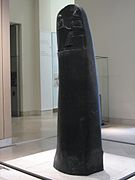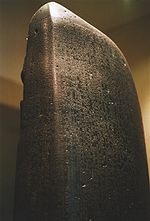- Code of Hammurabi
-
The Code of Hammurabi is a well-preserved Babylonian law code, dating to ca. 1780 BC (short chronology). It is one of the oldest deciphered writings of significant length in the world. The sixth Babylonian king, Hammurabi, enacted the code, and partial copies exist on a human-sized stone stele and various clay tablets. The Code consists of 282 laws, with scaled punishments, adjusting "an eye for an eye, a tooth for a tooth" (lex talionis)[1] as graded depending on social status, of slave versus free man.[2]
Nearly one-half of the Code deals with matters of contract, establishing for example the wages to be paid to an ox driver or a surgeon. Other provisions set the terms of a transaction, establishing the liability of a builder for a house that collapses, for example, or property that is damaged while left in the care of another. A third of the code addresses issues concerning household and family relationships such as inheritance, divorce, paternity and sexual behavior. Only one provision appears to impose obligations on an official; this provision establishes that a judge who reaches an incorrect decision is to be fined and removed from the bench permanently.[3] A handful of provisions address issues related to military service.
One nearly complete example of the Code survives today, on a diorite stele in the shape of a huge index finger,[4] 2.25 m or 7.4 ft tall (see images at right). The Code is inscribed in the Akkadian language, using cuneiform script carved into the stele. It is currently on display in The Louvre, with exact replicas in the Oriental Institute in the University of Chicago and the Pergamon Museum of Berlin.
Contents
History
Hammurabi ruled for 42 years, ca. 1792 to 1750 BC according to the Middle chronology. In the preface to the law code, he states, "Anu and Bel called by name me, Hammurabi, the exalted prince, who feared Marduk, the chief god of Babylon (The Human Record, Andrea & Overfield 2005), to bring about the rule in the land."[5] On the stone slab there are 44 columns and 28 paragraphs that contained over 282 laws. [6]
In 1901, Egyptologist Gustave Jéquier, a member of an expedition headed by Jacques de Morgan, found the stele containing the Code of Hammurabi in what is now Khūzestān, Iran (ancient Susa, Elam), where it had been taken as plunder by the Elamite king Shutruk-Nahhunte in the 12th century BC.
It is currently on display at the Oriental Institute Museum at the University of Chicago.[7]
Law
The Code of Hammurabi was one of several sets of laws in the ancient Near East.[8]
The code of laws was arranged in orderly groups, so that everyone who read the laws, would know what was required of them.[9] Earlier collections of laws include the Code of Ur-Nammu, king of Ur (ca. 2050 BC), the Laws of Eshnunna (ca. 1930 BC) and the codex of Lipit-Ishtar of Isin (ca. 1870 BC), while later ones include the Hittite laws, the Assyrian laws, and Mosaic Law.[10] These codes come from similar cultures in a relatively small geographical area, and they have passages which resemble each other.[11]
The Code of Hammurabi is the longest surviving text from the Old Babylonian period.[12] The code has been seen as an early example of a fundamental law regulating a government — i.e., a primitive form of what is now known as a constitution.[13][14] The code is also one of the earliest examples of the idea of presumption of innocence, and it also suggests that both the accused and accuser have the opportunity to provide evidence.[15] The occasional nature of many provisions suggests that the Code may be better read as a codification of supplementary judicial decisions of the king. Rather than being a modern legal code or constitution, it may have as its purpose the self-glorification of Hammurabi by memorializing his wisdom and justice. Its copying in subsequent generations indicates that it was used as a model of legal and judicial reasoning.[16]
Other copies
Various copies of portions of the Code of Hammurabi have been found on baked clay tablets, some possibly older than the celebrated diorite stele now in the Louvre. The Prologue of the Code of Hammurabi (the first 305 inscripted squares on the stele) is on such a tablet, also at the Louvre (Inv #AO 10237). Some gaps in the list of benefits bestowed on cities recently annexed by Hammurabi may imply that it is older than the famous stele (it is currently dated to the early 18th century BC).[17] Likewise, the Museum of the Ancient Orient, part of the Istanbul Archaeology Museums, also has a "Code of Hammurabi" clay tablet, dated to 1750 BC, in (Room 5, Inv # Ni 2358).[18][19]
In July, 2010, archaeologists reported that a fragmentary Akkadian cuneiform tablet was discovered at Tel Hazor, Israel, containing a ca. 1700 BC text that was said to be partly parallel to portions of the Hammurabi code. The Hazor law code fragments are currently being prepared for publication by a team from the Hebrew University of Jerusalem.[20]
See also
- Hippocratic Oath
- List of ancient legal codes
- Urukagina – Sumerian king and creator of what is sometimes cited as the first example of a legal code in recorded history.
- Code of Ur-Nammu – the oldest known tablet containing a law code surviving today, it predates the Code of Hammurabi by some 300 years
- Code of the Assura
- Babylonian law
- Cuneiform Law
- Quid pro quo
- Code of Hammurabi translated by R.F. Harper in 1904, University of Chicago Press
References
- ^ Review: The Code of Hammurabi, J. Dyneley Prince, The American Journal of Theology Vol. 8, No. 3 (Jul., 1904), pp. 601–609 Published by: The University of Chicago Press Stable URL: http://www.jstor.org/stable/3153895
- ^ Gabriele Bartz, Eberhard König, (Arts and Architecture), Könemann, Köln, (2005), ISBN 3833119438. The laws were based with scaled punishments, adjusting "an eye for an eye" depending on social status.
- ^ http://www.commonlaw.com/Hammurabi.html Code of Hammurabi
- ^ Iconographic Evidence for Some Mesopotamian Cult Statues, Dominique Collon, Die Welt der Götterbilder, Edited by Groneberg, Brigitte; , Spieckermann, Hermann; , and Weiershäuser, Frauke, Berlin, New York (Walter de Gruyter) 2007 Pages 57–84
- ^ Edited by Richard Hooker; Translated by L.W King (1996). "Mesopotamia: The Code of Hammurabi". Washington State University. http://www.wsu.edu/~dee/MESO/CODE.HTM. Retrieved September 14, 2007.
- ^ "Hammurabi's Code" [1], Think Quest, retrieved on Nov 2,2011.
- ^ Gabriele Bartz, Eberhard König. (2005). Louvre ( Arts and Architecture). Köln: Könemann. ISBN 3-8331-1943-8.
- ^ L. W. King (2005). "The Code of Hammurabi: Translated by L. W. King". Yale University. http://www.yale.edu/lawweb/avalon/medieval/hamframe.htm. Retrieved September 14, 2007.
- ^ "The Code of Hammurabi: Introduction," [2], Ancient History Sourcebook, March 1998, retrieved on 02 November 2011.
- ^ Barton, G.A: Archaeology and the Bible. University of Michigan Library, 2009, (originally published in 1916 by American Sunday-School Union) p.406.
- ^ Barton 2009, p.406. Barton, a professor of Semitic languages at the University of Pennsylvania from 1922 to 1931, stated that while there are similarities between the Mosaic Law and the Code of Hammurabi, a study of the entirety of both laws "convinces the student that the laws of the Old Testament are in no essential way dependent upon the Babylonian laws." He states that "such resemblances" arose from "a similarity of antecedents and of general intellectual outlook" between the two cultures, but that "the striking differences show that there was no direct borrowing."
- ^ "The Code of Hammurabi," [3], The History Guide, 03 August 2009, Retrieved on 02 November 2011.
- ^ What is a Constitution? William David Thomas, Gareth Stevens (2008) p. 8
- ^ Flach, Jacques. Le Code de Hammourabi et la constitution originaire de la propriete dans l'ancienne Chaldee. (Revue historique. Paris, 1907. 8. v. 94, p. 272-289.
- ^ Victimology:Theories and Applications, Ann Wolbert Burgess, Albert R. Roberts, Cheryl Regehr,Jones & Bartlett Learning, 2009, p. 103
- ^ For this alternative interpretation see Jean Bottéro, "The 'Code' of Hammurabi" in Mesopotamia: Writing, Reasoning and the Gods (University of Chicago, 1992), pp. 156–184.
- ^ Fant, Clyde E. and Mitchell G. Reddish (2008), Lost Treasures of the Bible: Understanding the Bible Through Archaeological Artifacts in World Museums, Wm. B. Eerdmans Publishing Co., pg 62.
- ^ Freely, John, Blue Guide Istanbul (5th ed., 2000), London: A&C Black, New York: WW Norton, pg 121. ("The most historic of the inscriptions here [i.e., Room 5, Museum of the Ancient Orient, Istanbul] is the famous Code of Hammurabi (#Ni 2358) dated 1750 BC, the world's oldest recorded set of laws.")
- ^ Museum of the Ancient Orient website ("This museum contains a rich collection of ancient ... archaeological finds, including ... seals from Nippur and a copy of the Code of Hammurabi.")
- ^ Tablet Discovered by Hebrew U Matches Code of Hammurabi
Bibliography
- Driver, G.R. & J.C. Miles (2007). The Babylonian Laws. Eugene: Wipf and Stock. ISBN 1-55635-229-8.
- Roth, Martha T. (1997). Law Collections from Mesopotamia and Asia Minor. Atlanta: Scholars Press. ISBN 0-7885-0378-2.
- Bryant, Tamera (2005). The Life & Times of Hammurabi. Bear: Mitchell Lane Publishers. ISBN 9781584153382.
- Mieroop, Marc (2004). King Hammurabi of Babylon: a Biography. Cambridge: Blackwell Publishers. ISBN 9781405126601.
- Hammurabi, King; C. H. W. Johns (Translator) (2000). The Oldest Code of Laws in the World. City: Lawbook Exchange Ltd. ISBN 9781584770619.
- Falkenstein, A. (1956–57). Die neusumerischen Gerichtsurkunden I–III. München.
- Elsen-Novák, G./Novák, M.: Der 'König der Gerechtigkeit'. Zur Ikonologie und Teleologie des 'Codex' Hammurapi. In: Baghdader Mitteilungen 37 (2006), pp. 131–156.
- Julius Oppert and Joachim Menant (1877). Documents juridiques de l'Assyrie et de la Chaldee. París.
- Thomas, D. Winton, ed. (1958). Documents from Old Testament Times. London and New York.
- Beck, Roger B.; Linda Black, Larry S. Krieger, Phillip C. Naylor, Dahia Ibo Shabaka, (1999). World History: Patterns of Interaction. Evanston, IL: McDougal Littell. ISBN 0-395-87274-X.
External links
- The Code of Hammurabi Translated by L. W. King, nicely typeset.
- HG-Hammu, historyguide.org
- Charles F. Horne, Ph.D. (1915). "The Code of Hammurabi : Introduction". Yale University. http://www.yale.edu/lawweb/avalon/medieval/hammint.htm. Retrieved September 14, 2007.
- speechisfire.com – Includes soundfiles with extracts from the Code being read in Babylonian by a modern scholar.
- Law Code of Hammurabi, king of Babylon | Musée du Louvre
- English Translation | University of Evansville
- Code Of Hammurabi – Ancestor of Modern Law
- Complete scientific English translation of the Code of Hammurabi
- Hammurabi's Code, Blaise Joseph, Clio History Journal, 2009.
Categories:- Legal codes
- Ancient Near East law
- Babylonia
- Manuscripts
- Codes of conduct
- Antiquities of the Louvre
- Bronze Age literature
- 18th-century BC works
- Ancient Near East steles
- 2nd-millennium BC steles
- Akkadian inscriptions
Wikimedia Foundation. 2010.




